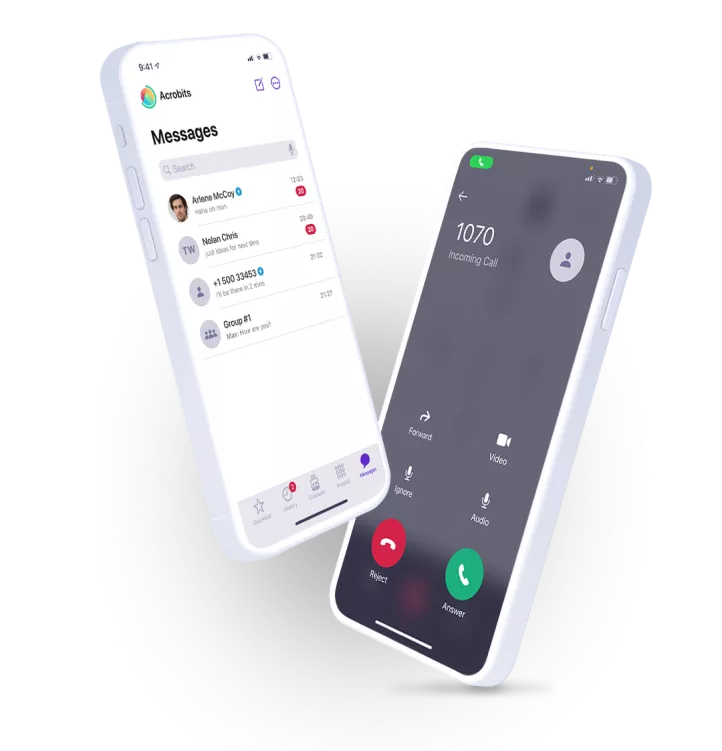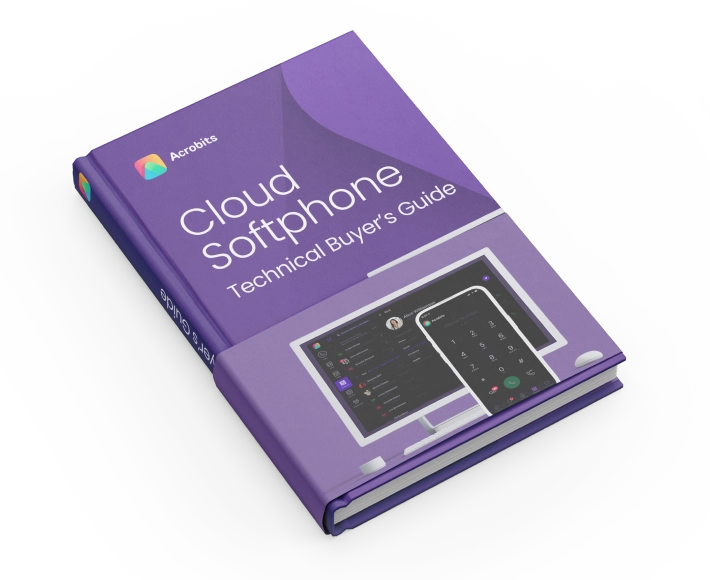
Powerful SIP softphone apps
Ideal for individuals looking for a better SIP softphone experience.
- Lifetime Updates
- Access to 100+ New Features
- Award-winning end-to-end encryption

In today’s digital age, softphones have revolutionized business communication, offering flexibility and cost-effectiveness. However, this convenience comes with its own set of security challenges.
Let’s dive deep into softphone security, exploring how to protect your systems from potential threats while ensuring compliance with regulatory standards.
Before we delve into the nitty-gritty of securing your softphones, let’s address a common misconception: Are softphones really more vulnerable than traditional communication tools?
A comprehensive risk analysis of VoIP systems found that softphones aren’t inherently riskier than other common internet applications.
The study showed that while softphones can be targeted, their vulnerability level is comparable to instant messaging apps, download managers, or web browsers.
This puts the security risk into perspective, helping us understand that with proper measures, softphones can be just as secure as other digital communication tools we use daily.
However, this doesn’t mean we can afford to be complacent. The key lies in understanding the unique security landscape of softphones and implementing targeted security measures.
Related read:
Encryption is your first and most crucial line of defense against eavesdropping and data interception. It’s the digital equivalent of speaking in a code that only the intended recipient can understand.
When selecting a softphone system, prioritize those that use robust encryption protocols like TLS (Transport Layer Security) or SRTP (Secure Real-time Transport Protocol).
A study on VoIP security by the National Institute of Standards and Technology highlights these protocols as essential for ensuring encrypted voice data transmission. TLS, in particular, creates a secure channel between communicating applications, safeguarding both privacy and data integrity.
But why are these protocols so effective? TLS uses a combination of symmetric and asymmetric encryption. The initial handshake uses asymmetric encryption to securely exchange a symmetric key, which is then used for the bulk of the communication. This approach combines the security of asymmetric encryption with the speed of symmetric encryption.
Protect your calls with Groundwire. Cutting-edge encryption to safeguard your communications. Experience secure yet crystal-clear calls now.

Ideal for individuals looking for a better SIP softphone experience.
Weak passwords are like leaving your front door wide open with a “Welcome, Hackers!” sign. Implementing robust authentication measures is crucial to keeping intruders at bay.
Consider implementing multi-factor authentication (MFA) for an extra layer of security. MFA typically includes:
Recent research on mitigating DDoS attacks in VoIP systems emphasizes the importance of strong authentication. The study suggests that MFA can significantly reduce the risk of unauthorized access, even if one factor is compromised.
But how does MFA actually work? Let’s say an attacker manages to steal your password. Without MFA, they’d have full access to your account. With MFA, they’d still need your phone or fingerprint to gain access, adding a crucial additional layer of security.
Software updates are not just about new features; they often include critical security patches. Making it a habit to keep your softphone software up-to-date is like regularly changing the locks on your doors.
Many softphone systems allow for automatic updates. Enable this feature to ensure you’re always running the latest, most secure version of the software.
But why are updates so crucial? Cybercriminals are constantly finding new vulnerabilities in software. When these vulnerabilities are discovered, software companies race to patch them. By keeping your software updated, you’re ensuring that known vulnerabilities are fixed as quickly as possible.
Your softphone is only as secure as the network it’s running on. Think of your network as the neighborhood your softphone lives in – you want it to be as safe as possible.
A Virtual Private Network (VPN) can add an extra layer of security, especially when using softphones on public Wi-Fi networks. Recent studies on cloud and IP telephony security highlight VPNs as a crucial tool for enhancing softphone security, particularly in remote work scenarios.

A VPN works by creating an encrypted tunnel for your internet traffic. This means that even if someone manages to intercept your data, they won’t be able to read it. It’s like sending your mail through a secret underground tunnel instead of the regular postal service.
Even the best security measures can be undermined by human error. Educating your team about softphone security best practices is like teaching everyone in your household how to use the security system properly.
Develop a comprehensive security policy that outlines proper use of softphones and the steps employees should take to maintain security. This policy should cover:
Remember, a policy is only effective if it’s understood and followed. Regular training sessions can help ensure that your security policy remains at the forefront of your employees’ minds.
When it comes to softphone security, compliance with regulations like HIPAA (Health Insurance Portability and Accountability Act) and GDPR (General Data Protection Regulation) is crucial, especially in industries dealing with sensitive information.
Recent studies on VoIP security issues emphasize that compliance isn’t just about avoiding fines—it’s about protecting your clients’ trust and your business’s reputation.
The General Data Protection Regulation (GDPR) applies to all companies processing the personal data of EU citizens, regardless of the company’s location. For softphone users, this means:
Compliance with GDPR is not just a legal requirement but also a way to build trust with your European customers and partners.
But what does compliance actually mean for softphone users? Let’s break it down:
As technology evolves, so do the threats to softphone security. Staying ahead of these threats requires a proactive approach.
Related Read
Securing your softphone system is not a one-time task, but an ongoing process. By following these steps and staying vigilant, you can enjoy the benefits of softphone technology while minimizing security risks.
Remember, the goal is not to achieve perfect security – that’s an impossible target. Instead, the aim is to make your softphone system secure enough that attacking it is not worth the effort for most cybercriminals.
Ready to beef up your softphone security? Here’s a simple action plan to get you started:
Remember, security is a journey, not a destination. Stay informed, stay vigilant, and don’t be afraid to seek expert help when needed.
Not necessarily. While softphones do have unique security considerations, with proper measures in place, they can be just as secure as traditional systems. The key is in understanding and addressing the specific vulnerabilities of softphone systems.
It’s best to enable automatic updates if possible. If not, check for updates at least weekly and apply them promptly. Remember, each update could contain critical security patches.
While it’s not recommended, if you must use a softphone on public Wi-Fi, always use a VPN to encrypt your connection. This adds an extra layer of security to protect your communications from potential eavesdroppers on the public network.

Every telecom provider knows the appeal of a quick fix. Deploy a generic softphone app, get your users online, and move on. But as the market surges toward $400 billion by 2034, the cracks in this approach are becoming impossible to ignore. Scaling, branding, and innovation all hit a ceiling fast. The hidden cost of […]

Picture this: your softphone app aces every backend test, but users drop off after the first call. Why? Technical reliability alone won’t win the adoption game, intuitive onboarding, seamless UI, and robust call quality all matter equally. Testing and launching a softphone app is a two-front battle, and neglecting either side puts your brand and […]

Not every VoIP user needs the same thing. Some just want a rock-solid app to connect their SIP line. Others need to launch a white-label softphone under their own brand. Acrobits offers two very different tools to cover both ends of that spectrum: Groundwire and Cloud Softphone. Feature Groundwire Cloud Softphone Pricing $9.99 one-time purchase […]

For many small and medium-sized businesses, the traditional PBX (Private Branch Exchange) phone system has long been the backbone of daily communication. As remote work becomes the norm and digital transformation accelerates, these hardware-bound systems are increasingly feeling like a bottleneck: they are costly to maintain, inflexible, and ill-suited for modern workflows. If you’re an […]